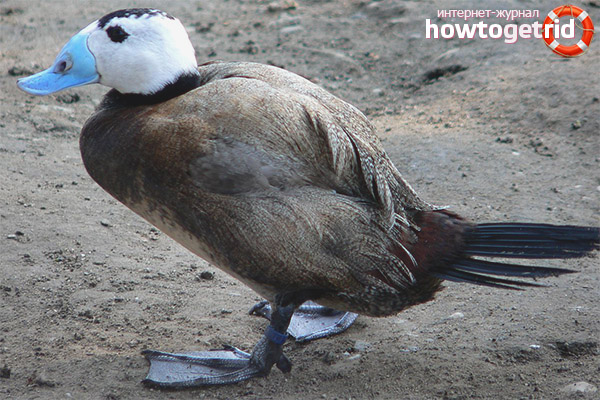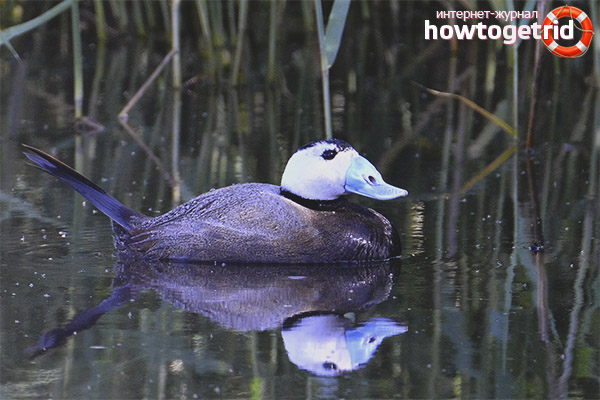The content of the article
Under the seal means the representative of the duck family, which refers to medium-sized individuals. By its weight category, the bird hardly reaches 1 kg., But more often there are even smaller individuals in terms of overall characteristics. When the breeding season begins, they acquire a completely different color, the behavior also changes. But let's not get ahead of ourselves, we will analyze the subtleties in the order of the queue.
Description
- The beak is large, massive, stands out against the general background. A characteristic feature of these individuals is bloating on its beak, it is clearly visible and distinguishes the birds from the rest. Bloating begins in the nostrils and continues to the bite. In representatives of male affiliation, this trait stands out more strongly than in females.
- When the males find their mating coloring, their head looks white, and a black cap flaunts in the occipital and frontal areas. The abdominal region, the lateral parts of the body, as well as the feathers and shoulder blades are painted beige with a pattern across. The chest and the area above the tail are pigmented with chestnut. The tail and tail are brown with blackish spots. The beak is light with a gray and bluish tint.
- When summer comes, the males turn beige and gray. A large black spot is visible in the upper part of the neck. The beak is no longer as bluish as during the mating season. Females, in contrast, are ocher with beige patterns in plumage color. There are dark patches in the chest and tail, while the tail itself is brown.
- In males, the cap is black, while in females it is brown and wide. It goes right up to the back of the head, starting from the beak. If we compare female and male individuals, then the females have a transverse strip in the eye section, it is brown. As for young animals, the plumage of these individuals practically coincides with the color of the male, but the feathers are grayish and light. Females and young animals boast a different beak color than males, namely gray-brown.
- When birds are just born, they are pigmented in a brownish tone with gray spots. The head is dark, and the chest is light. In the area of the cheeks there is a strip. When the chicks hatch, their tail feathers are very stiff. When chicks hit the water surface, their tail rises, like the older generation.
Lifestyle
- Most of the life, these representatives of the family live in the aquatic environment, which is not surprising, since they belong to the category of ducks. They rise reluctantly into the air, and only after taking the acceleration from the surface of the water. They love to dive, they can go under water to a depth of up to 10 m, which is impressive for many experts. Swim without diving, capable of up to 50 m.
- When preparing for the construction of dwellings for future offspring, they choose an aquatic environment with shallow depth. It is important that the habitat contains a lot of plant foods. There are no definite breeding dates, it is only known that this occurs at the end of spring and lasts until mid-summer. Housing for babies is built in the form of a floating vessel, but it can also be motionless. It all depends on the material available in the habitat.
- When the female makes a laying, about 8 eggs are obtained, sometimes less. These birds do not estimate laying down. At first, the female does not move away from the nest, carefully hatching offspring. But then she can go away for a long time, because embryos are able to control their thermoregulation independently by the breakdown of fats.
Spread
- Represented individuals often live in the Palearctic. The rest can be said that such birds have a different habitat in mosaic order. Individuals can often be found in western China and western Mongolia.Birds also live in Spain and Morocco.
- Among other things, 4 main habitats can be distinguished. For example, on the lands of North America, the individuals represented most of the time lead a sedentary lifestyle. The population that is found in East Asia often flies to other countries.
- In this case, the birds fly away to nest on the lands of eastern and western Siberia. They can also fly to Mongolia. Wintering individuals in Pakistan. Separately, it is worth highlighting the Asian migratory population.
- In such individuals, nesting sites are located in Kazakhstan and in the south of Russia. Wintering birds fly to Eastern Europe and the Middle East. Moreover, birds can fly to Western Asia, Greece, Ciscaucasia and the Caspian Sea.
- There is also a sedentary population that lives throughout the year in Spain. In the Russian Federation, birds nest on lakes with reed beds and on estuaries located in estuaries. Nesting sites are also located in the forest-steppe and steppe zones.
Breeding
- In the nesting grounds, which are located on the territory of the Russian Federation, the considered representatives of birds arrive quite late. These birds can cost a nest on the edges of the thickets and reed rafts. Also, dwellings are often located between the reed stalks on the reaches.
- The masonry period may vary significantly due to the difference in the geographical location of individuals. At one time, the female is able to bring a maximum of 9 eggs. They have a grayish-white color. After only 3 weeks, the young growth is already beginning to hatch into the light. Offspring are hatched exclusively by the female. She also brings up chicks.
- The chicks are already appearing quite large in size. Almost immediately, they are able to dive, swim and move around. A month later, young growth becomes completely independent.
It is worth noting that the considered individuals sometimes lay their own eggs to other bird species. This phenomenon is called parasitism. Representatives of such birds are unique in nature. Unfortunately, their numbers are gradually declining. Therefore, the view is taken under protection.
Video: Savka (Oxyura leucocephala)











Submit